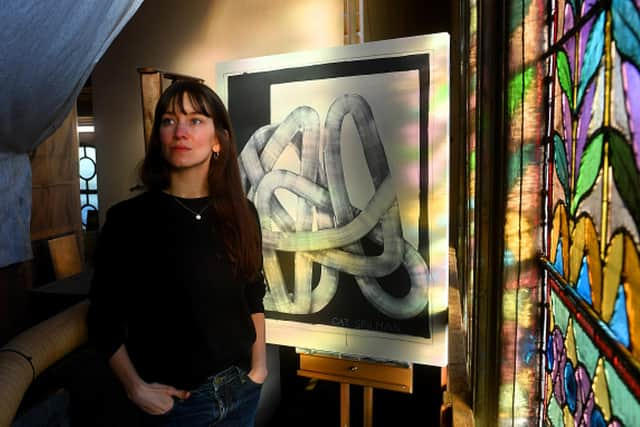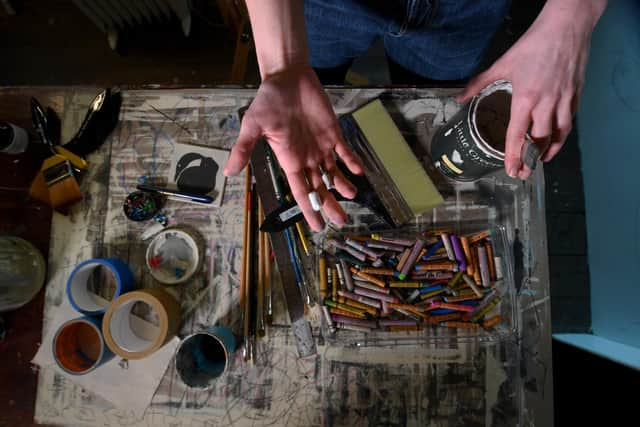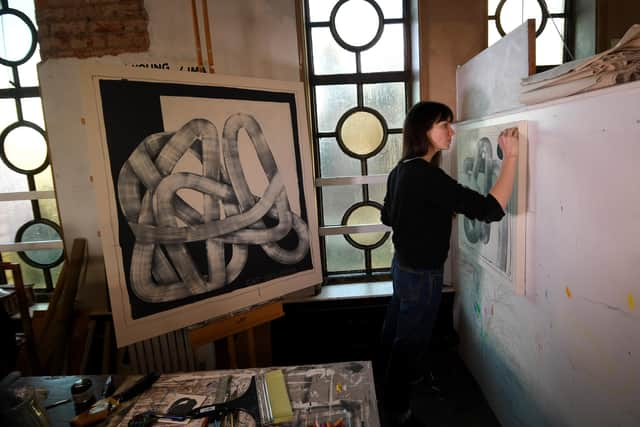How artist Cat Spilman’s paintings have come out of tragedy of losing husband to cancer
“They’re two different sides of me,” she says. “Sometimes I go days without having any interest in the solid black pieces, then sometimes I go days when I am not interested in doing the lines. I think they are just different parts of who I am.” Cat has tried starting with a sketch but that doesn’t work. “I always hate those paintings – they just have no energy. It sounds kind of corny, but they all are coming from a really emotional place. If I try to plan them or have any kind of idea of what I want them to look like in the end, then they just don’t have any life.”
Cat has a small studio at Southlands Methodist Church in York, painting there unless it is too cold when she retreats to her home nearby. She has established herself in a surprisingly short time. Painting for not much over a year, she is represented by Rhodes Contemporary Art on North Portland Street in London, where she had her first show, with another due at the end of this year. Before that, she has a show in March at the Suburbia Contemporary gallery in Barcelona. She knows she has been lucky, mentioning this often, yet fortune rubs both ways, as Cat’s life shows.
Advertisement
Hide AdAdvertisement
Hide AdBorn in Ohio, a little south of Cleveland, she moved to New York at 18 to study film at the School of Visual Arts. She later worked as a scenic artist on TV shows and films which is how she met her husband. Jordan, also a scenic artist, grew up in Riccall, near Selby.


“I met him doing a pilot for a show called Sneaky Pete,” she says. “We worked together as friends for about a year and then started dating.” But Jordan was diagnosed with cancer in 2019 and when the first Covid lockdown hit, they moved to York. “We briefly talked about Riccall,” Cat says, but that was quite the jump from Manhattan. “It’s lovely, it a beautiful village but I really need to be able to walk to buy my groceries and coffee and not have to drive.” Jordan died, aged 36, in 2021. Cat has stayed in their house, feeling York is a good place to raise her daughter, Penny, who is now three.
Having a studio space with other artists helped her to “process a lot of things. I just started painting because I needed that time and space, and I hadn’t really painted before.”
The Rhodes Gallery spotted Cat, who is 32, on Instagram, which she sees as “kind of this necessary evil. It’s self-promoting and you’re inviting all these people in, and I find that… it’s not invasive and sometimes it’s quite nice because you feel like you are communicating in a way that you wouldn’t otherwise be able to do. But it’s distracting. At the same time, it’s the easiest way for your art to be seen and it’s invaluable if that’s what you want to do for a living.”
Advertisement
Hide AdAdvertisement
Hide AdCat never planned to follow her mother, Sally Tharp. “My mum is a painter, so I’ve always had art around me. She has a big art collection. I was determined not to do what my mum did.” Her mother paints photo-realistic oil paintings. “They’re the polar opposite of mine. They’re very realistic and colourful.”


When she started painting, Cat sent a message to the WhatsApp group in her street, asking for any old house paint they might have but she realised quite quicky that she needed to buy the colours that she wanted to use. “I decided really early on that I’ve always had quite a monochromatic aesthetic. When I went to film school, my thesis was on black and white negative reversal film. It can be bold and dynamic but it’s also elegant and simple. I picked these two colours from the beginning and said I’m going to limit my palette and it will force me to really focus on the design.”
Using emulsion from Little Greene, the house paint company, she paints the edge of the stretched canvas off white, then paints the middle black, before starting on the picture.
“My crayon marks go on the black, and almost all of my paintings have some of those original marks that show through, behind the lines or behind the figures. I like to show some process. I’ve never done my borders with a ruler. I don’t like it to be too clean or neat.” She likens painting to a long but familiar car journey.
Advertisement
Hide AdAdvertisement
Hide Ad“You know when you go for a really long drive and it’s a straight drive and you don’t have to think about it because you’ve made it a lot of times before. An hour passes, and you haven’t even been thinking about driving. That’s what it feels like. You get to the end of the painting, and you can’t really remember doing the painting. It is meditative and cathartic, but that’s the whole point.”


Her inaugural London show featured 17 paintings, so she had to leave the studio and paint at home, taking over the dining room. The Barcelona show will feature larger paintings, something that excites her, so her dining room is disappearing again. Although people sometimes wonder if Barbara Hepworth might be an influence, Cat mostly points to two American artists, Robert Motherwell and Cy Twombly. “Everything influences me, old black and white films influence me, Bauhaus has been a big influence. And certainly, the minimalism and gestures of Cy… he’s probably the biggest inspiration. Sometimes I look at something and can see what it resembles. But paintings should be a conversation, and the artist brings half of the conversation, and the viewer brings the other half, and that interaction is what makes it interesting.” Cat is fluent and engaging about her surprising new life as an artist, yet a shadow clearly haunts this success.
“I think about that all the time,” she says. “If Jordan hadn’t been sick, I probably would never have been making these paintings. I would happily trade this to have him back, but you go through this thing that is so devastating and you feel like this is such a healthy thing to come through that. I feel really grateful for this because, I won’t say it’s saved me, but it’s given me something that’s so positive to focus on.”
www.catspilman.com